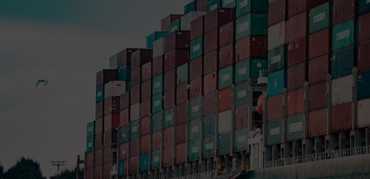
Shipping Alliances: New Mergers



A new grouping of shipping lines, called THE Alliance, is seeking to dominate the global movement of cargo in the ocean freight industry in the coming years. The new partnerships are still subject to regulatory approval. But one thing is certain: **through alliances, shipping lines seek to take on bigger rivals and control rates **. Together, the partners have greater leverage. Let’s have a look at the influence of alliances on the future of container shipping. Particularly, how it’s indicating a trend towards megaports and megaships.
Shipping Lines Alliances: The Changes
The 14 largest shipping companies make up 73.1 percent of the market share , and almost all of them belong to alliances. As of July 2016, the world’s shipping alliances are aligned as follows:
2M Alliance: Maersk and MSC
Ocean Three Alliance: CMA CGM, UASC, China Shipping
G6 Alliance: NYK Line, OOCL, APL, MOL, Hapag-Lloyd, HMM
CKYHE Alliance: K Line, COSCO, HANJIN, Evergreen, Yang Ming
Among the top independent carriers are PIL, ZIM, Wan Hai Lines, X-Press Feeders and KMTC. Come April 2017, the world of shipping alliances will see changes, as reorganizations will affect nearly all of the above lines. Hapag-Lloyd, which recently merged with UASC, and five Asian carriers want to form the new vessel-sharing alliance called THE Alliance. In addition, HMM will soon join Maersk and MSC in the 2M alliance. This is how it will look post-reorganization:
- 2M Alliance: Maersk, MSC
- Ocean Alliance: CMA CGM, China Shipping, APL, OOCL, Evergreen
- THE Alliance: K Line, Yang Ming, HANJIN, MOL, Hapag-Lloyd, NYK Line, UASC
*HMM was initially set to join 2M Alliance but their entry has since been rejected. The trio will instead engage in a 2M+H partnership.
THE Alliance has signed an agreement for an initial five years. It’s set to be one of the leading networks in the container shipping industry. It combines around 3.5 million TEU or 18% share of the world’s container fleet capacity. For a more comprehensive view, take a look at this infographic done by Xeneta.
![]()
UPDATE (25th November 2016)
Please note that there have been various changes in shipping alliances since this post was first published:
- CMA CGM has acquired APL
- Hapag-Lloyd has merged with UASC
- COSCO and China Shipping have merged to form China COSCO Shipping
- HMM has been denied 2M alliance entry
- Hanjin Shipping has filed for court receivership
- Japanese carriers NYK, MOL, and K-Line have merged their overseas operations
- Maersk has acquired Hamburg Süd
What Are The Benefits Of Shipping Alliances?
Alliances have become increasingly important in the global shipping industry. Shipping lines seek to cut operational costs by partnering and working together in alliances. Members share ships, networks, and port calls. These partnerships are the equivalent of airline alliances in the aviation world.
In practice, sharing vessels allows ocean alliances to operate without having to increase the number of ships. In the 2M alliance, for example, MSC and Maersk can use their partner’s vessel space. Shipping lines benefit by being able to offer a level of service they simply cannot cover with only their own ships as a single shipping loop can tie up a vessel for weeks.
Larger shipping lines can rationalize their resources in an alliance. But it is mainly the smaller lines that reap the greatest benefits: without having to increase their fleet, they can serve more destinations. As companies pool their containers on larger vessels, the savings quickly add up as megaships are much more fuel-efficient.
Megaports: How Shipping Alliances Are Changing Landside Operations
Currently, the operational benefits of shipping alliances apply to sea-level and largely end with the unloading of containers. On land, alliances split into individual lines with their own terminal agreements, trucking contracts, management, and arrangements. Individually, the lines lose the scaling advantage. In the future, we can expect changes here as alliances negotiate and work to overcome operational difficulties and reduce the overall cost base for land-side operations. Joint operations of shipping lines on land can include:
- Terminals: Shipping alliances use multiple container terminals within the same port today. Linking operating systems and management teams, alliances can effectively merge several terminals and operate as if they were one. The end result would be an increase in efficiency and reduction in turnover times.
- Rail: Working together on inter-modal rail transportation, alliances can benefit from improved flow and logistics. It also allows them to manage rail volumes through a single intermodal company instead of having to rely on differing agreements with each shipping line.
- Trucking: The combined volumes gives alliances the advantage of lower trucking rates. Through a more centralized management, transport costs and times can be reduced.
With their combined volume, shipping alliances have power over ports and can pressure them for more favorable conditions and improved services. The size of alliances allows them to negotiate better tariffs at ports and push for discounts for volume. In contrast, the smaller, independent lines end up having to pay higher charges. The power of shipping alliances is an incentive for ports to stay competitive, as they otherwise have little means to reward loyalty. As a result, ports grow into megaports with terminals growing in size, channels being deepened to accommodate megaships, and multi-modal transportation options being added where possible.
Megaships: Alliances Combine Their Volume
Carriers have been building larger and larger ships. These megaships are more fuel-efficient and can deliver more cargo in one haul. Combining their volume, shipping lines in alliances can offer frequent and predictable transit times and more frequent service. Thanks to vessel sharing, they don’t need to upgrade their fleet.
Just like alliances pressure ports to accommodate their needs, their use of megaships is shaping other infrastructure as well. By 2030, a new generation of vessels with 18,000 to 20,000 TEUs will make up more than 60% of the world’s total containers fleet. Both the Panama Canal and the Suez Canal have already been extended to allow for these larger ships to pass. Instead of paying for the investment through higher tariffs, shipping alliances have successfully pressured canal authorities to offer lower rates.
Alliances Shape The Future Of Container Shipping
The trend of megaports and megaships will definitely continue and even accelerate with the coming wave of new shipping line consolidations and realigned alliances. Even though approval of regulators and authorities is still pending, shipping alliances already hold great power. Regardless of how exactly new alliances will be comprised, many service providers such as feeder lines may have to renegotiate their existing businesses. The likely result is further pressure on rates. Shippers hardly have a say on their port preferences; to mitigate their risk, they have to spread their volume across carriers belonging to different alliances. That’s something they’re already doing today, but most likely to do more in the future.
Related Articles

